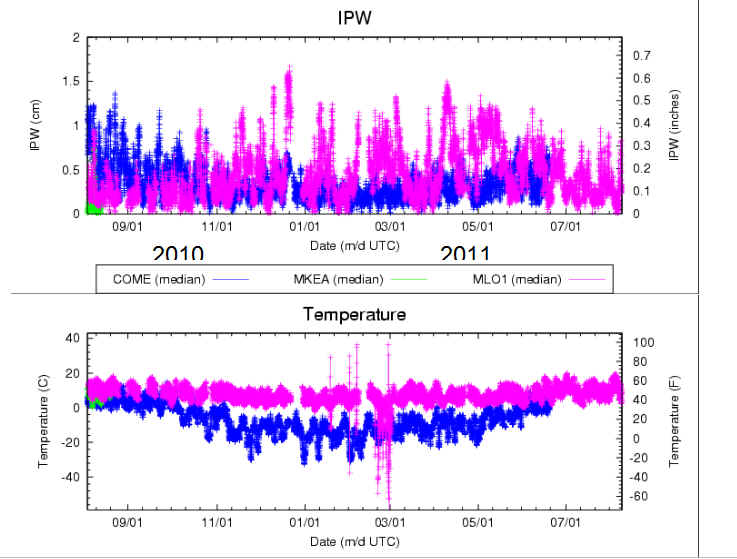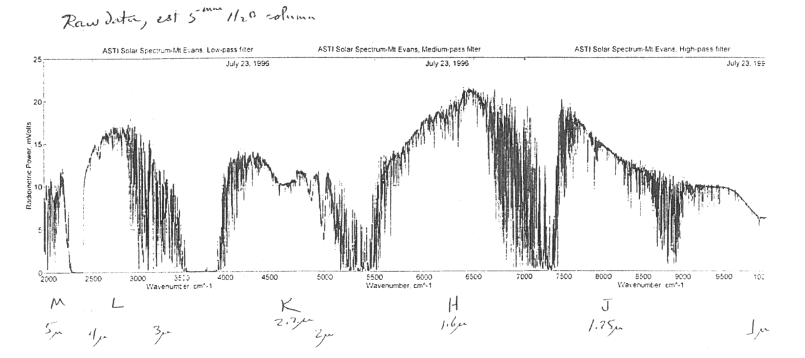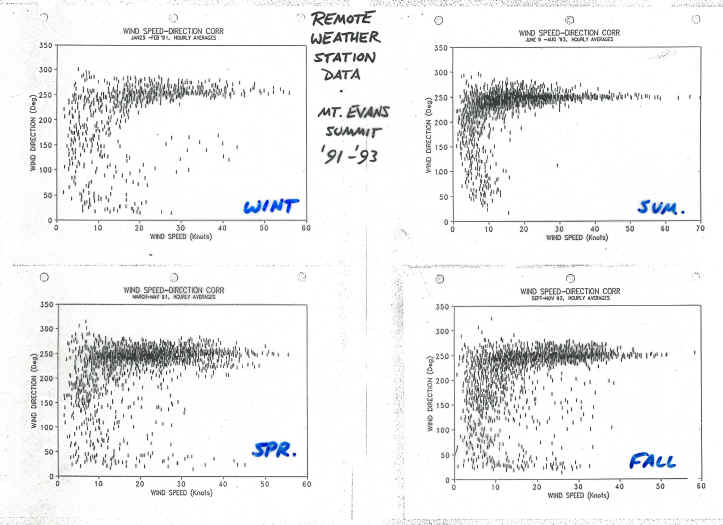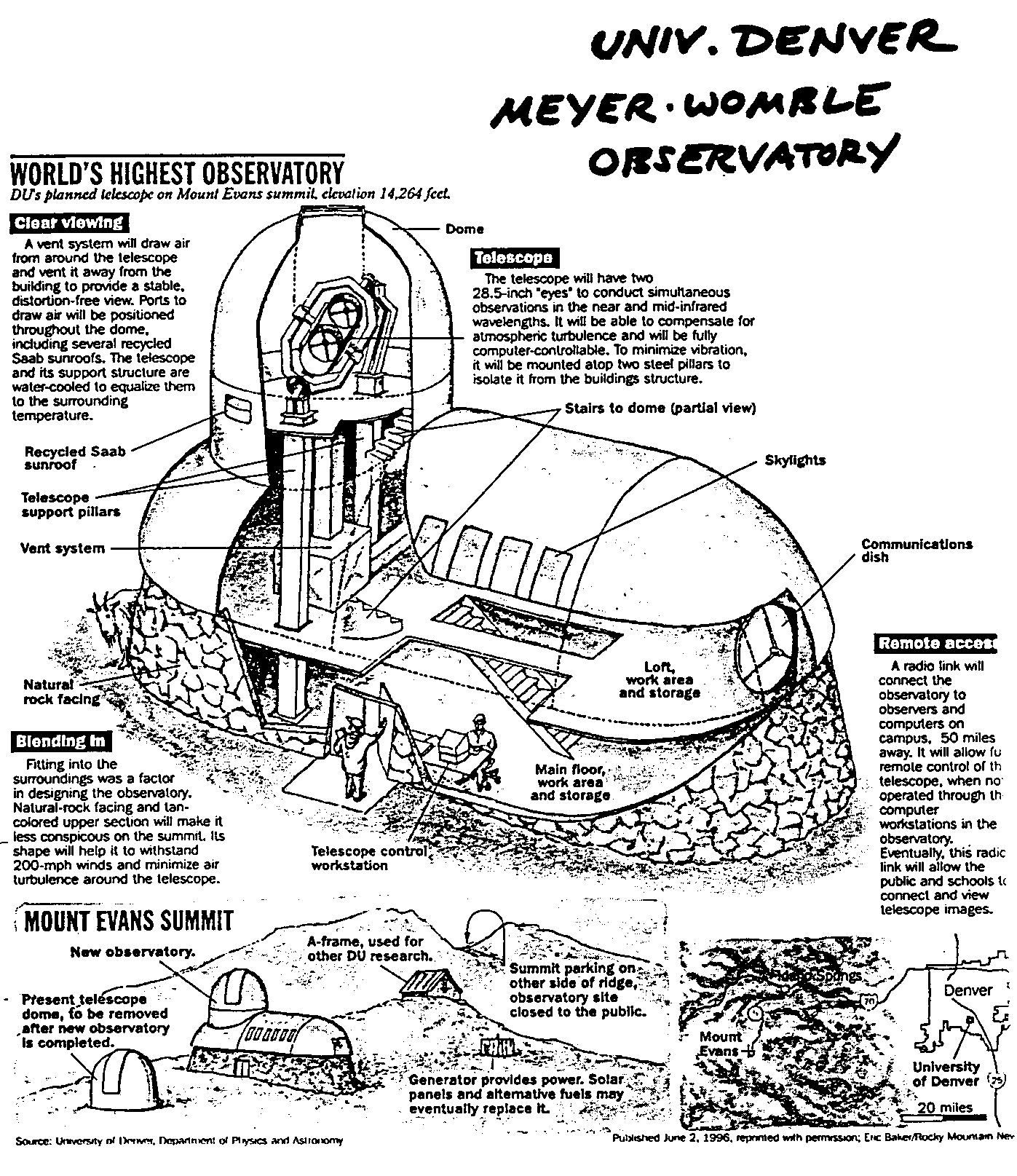

Observing conditions are world-class (some of the time, see data below); provides outstanding student opportunities; there are not many road-accessible extreme high altitude sites in the USA; line of signt internet link to campus 50 km away; global warming may make this site accessible year-round; includes a base camp with amenities at Echo Lake (elev 10,600 ft); an attractive, naturally air-conditioned getaway from your hot and sweaty lowland campus in summers; an endowed chair in astronomy, associated with this site, will become available in due course; metro Denver amenities are readily accessible to support these uses; Forest Service special use permit recently renewed for 30 years, etc.
NEXT STEPS: Enlist interested parties (email Prof.Stencel, robert.stencel@du.edu ); conference calls during first half of 2017; site visits starting in late spring 2017. Otherwise, without expressions of external interest, we will conclude that the effort is not sustainable and proceed to raze the facility, abandon site and use permit, causing a loss to ground-based astronomy.
Update 2018 July 4: Lacking expressions of interest, and not having sufficient budget or staffing to continue, we have begun the process of de-commissioning Meyer-Womble Observatory atop Mount Evans, Colorado. Bids for demolition and removal will be solicited in due course.
BACKGROUND:
Mount Evans in the Colorado Front Range hosts one of the highest altitude observatories in the USA, with its telescopes at an elevation of 14,148 ft (4,312 m; long.105W, lat. 39N). The observatory is operated under a Forest Service use permit, recently renewed for another 30 years. At times, observing conditions (seeing, water vapor column, etc.) can be as good as anywhere on earth - data provided below. The existing twin 0.72 m f/21 R-C telescopes are solar powered and internet connected.
However, jet stream winds in early 2012 destroyed the 15 year old, 22.5 ft diameter Ash dome. The replacement, custom dome design/install was rushed, and suffers from a number of flaws. Given that, plus the aging telescope and control system, we are planning, plus seeking partners and investor funds, to re-develop the facility. Facets of this may include replacing the twin apertures with a single full-aperture telescope for remote operations and sky monitoring, replacing the flawed dome with an innovative dome design, renewable power upgrades, and outreach programs for the many thousands of mountain visitors seasonally.
As elsewhere, we are grappling with increases in atmospheric water vapor and out-of-control regional light pollution growth, but believe that the site continues to hold great potential. Interested parties are invited to contact the author for further information. Website: http://www.du.edu/~rstencel/MtEvans .
SITE INFORMATION: 75 paved-road miles from Denver; Base facilities at 10,600 ft. elev., 14 miles from summit; Continuous use since 1930 (cosmic ray study, then astronomy); Operated under special use permit with US Forest Service; Solar photo-voltaic & battery power, plus backup generators; Line of sight 100 Mbps internet link to Denver U campus.
SITE STATISTICS: 2/3 nights spectroscopic, 1/2 photometric; Median uncorrected seeing, 1 arcsec; Water vapor as low as 1 mm (see data below, and online).
Figure 1a,b, precipitable water vapor and temperature records, 2010-2014, NOAA instrumentation, includes comparison with Mauna Kea.


Figure 2: Near-infrared transmission spectrum data obtained at Mount Evans, showing transparency in the JHKLM photometric bands under 5 mm waver vapor overburden. Paper on J & H band photometry from Mount Evans appeared in JAAVSO: http://adsabs.harvard.edu/abs/2008JAVSO..36..127B

Figure 3: seasonal wind rose data sampled from a decade of on-site atmospheric monitoring in the 1990s.

SEEING STATISTICS -
http://mysite.du.edu/~rstencel/MtEvans/SiteSurv.html ; http://mysite.du.edu/~rstencel/MtEvans/WSMEreport9612 .We continue to assemble evidence that Mt.Evans may provide one of the best INFRARED and SUB-MILLIMETER SITES available in the CONTINENTAL U.S., due to its extreme high altitude (4,303 meters), accessibility (paved road to summit), infrastructure (new 2,100 sq ft observatory building, nearby base camp at 10,600 ft) and proximity to transportation, supplies and universities in and around Denver.
Several measurements of the seeing quality atop Mt. Evans have been completed with very promising results. We plan to augment measurements. The existing telescope dtasets provide definition of the summer seeing statistics for the Mt. Evans site. In the following paragraphs, we present up to date seeing measurements conducted on Mt. Evans. A CDROM of data obtained with an CCD cameras is available on request. Acoustic Soundings: As reported by Stencel et al. (1994 BAAS 26:1321 = http://adsabs.harvard.edu/abs/1994AAS...184.2607M ), vertical acoustic sounding measurements were made at the Mt.Evans site during September 1994. Primary conclusions include that (a) refractive and turbulent parameters are comparable to those reported at Mauna Kea by Forbes and others; (b) the measured values imply the atmospheric contribution to the seeing disk due to turbulence in the 100 or so meters above the site is no more than 0.1 arcsec; (c) the deduced Fried parameter based on these measurements can be as large as one or more meters. C(n)^2 values were found to be comparable to Mauna Kea reported testing, circa 1E-17 m(-2/3). See the full report available on request. Double Star Images: CCD images were acquired at the summit for selected double stars. Double stars were used to accurately determine the plate scale of the images. Seeing was ascertained by measuring the full width half maximum of the individual stars. Visual inspection of the images at the telescope suggest the camera did not ideally record the true seeing quality, due to residual aberrations in the 10 and 24 inch telescopes used. None of this data has been deconvolved with the telescope diffraction limits (0.25 and 0.15 arcsec), nor enhanced by any active optics. Despite these problems with CCD frames, it seems reasonable to conclude based on these measurements that at least "arcsecond" quality seeing (0.68 arcsec formally) is routine on Mt. Evans. In addition, the telescopes were housed in a ground level dome with no airflow or thermal compensation for degrading effects from the dome. The Meyer Binocular Telescope should be capable of doing superior measurements of this kind, because airflow and thermal management has been included in its design (plus provision for adaptive optics).H-DIMM Survey: Hartmann mask differential image motion montoring offers the potential to directly observe the seeing cell sizes and their fluctuations (cf. Bally et al. 1995). We conducted a series of these measurements during summer 1995 and present the results here. Fried parameters were found to occur between 5 and 24 cm, and these appear to correlate with azimuth of the star observed, being larger toward the west (windward) side of the sky. Analysis is ongoing, and preliminary results show a range of r(o) values from 5 to 10 cm on the leeward side of the observing site, to 10 to 35 cm on the windward (upwind) side, as might be expected for air flowing over the ridge. These values include unmitigated dome seeing effects.
Site Topography: Mt. Evans experiences excellent seeing due to its isolated location and elevation above surroundings. The site is situated some 3,000 feet above tree line and the routine west-southwest winds come from a direction that is unobstructed for several miles. The only local obstruction to the telescope site is the true summit situated to the north. Figure 1D shows several topographical surveys of the mountaintop. The prevailing wind direction is also noted. Note the steep contours along the southwestern slope, a feature known to coincide with sites of excellent seeing such as the MMT on Mt Hopkins, Arizona.
Still skeptical? Good, but come visit and examine conditions for yourself. Additional documentation available on request.
FACILITY NOTES: overview and interior


Special thanks to student helpers Tristan Wolfe, Justus Gibson, Brian Kloppenborg, Nick Long, Aaron Bradley, plus Adam Jones, Aaron Reid, Chuck Seese and many others.
Extra special thanks to William Herschel Womble for support of astronomy at U of Denver.
[end]